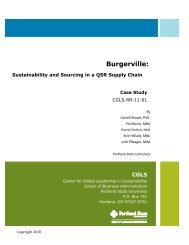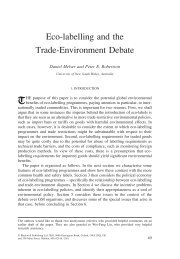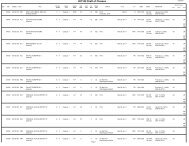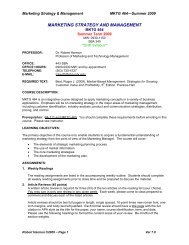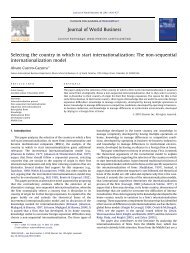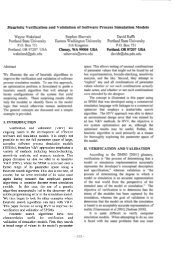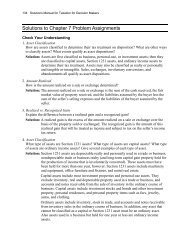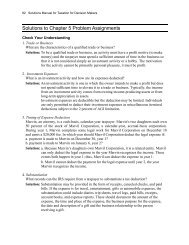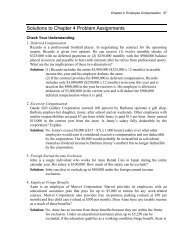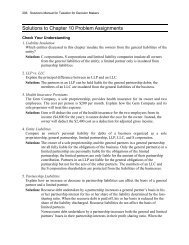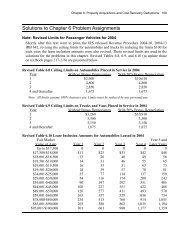Co-ordinating Sustainable Cotton Chains for the Mass Market
Co-ordinating Sustainable Cotton Chains for the Mass Market
Co-ordinating Sustainable Cotton Chains for the Mass Market
Create successful ePaper yourself
Turn your PDF publications into a flip-book with our unique Google optimized e-Paper software.
co-<strong>ordinating</strong> sustainable cotton chains <strong>for</strong> <strong>the</strong> mass market<br />
<strong>Co</strong>-<strong>ordinating</strong> <strong>the</strong> sustainable cotton chain at OTTO<br />
In analysing <strong>the</strong> sustainable cotton chain, two major differences to a conventional chain<br />
can be distinguished. First, <strong>the</strong> co-ordination of <strong>the</strong> initial phase, i.e. <strong>the</strong> one within<br />
which measures need to be taken to set up <strong>the</strong> chain, was significantly different from<br />
<strong>the</strong> advanced phase, i.e. <strong>the</strong> one within which <strong>the</strong> chain needs to be maintained in <strong>the</strong><br />
medium term. Second, bilateral co-ordination between neighbouring partners at a more<br />
operational level in <strong>the</strong> conventional chain was complemented by a chain-wide level,<br />
below also referred to as a global level. There<strong>for</strong>e, in <strong>the</strong> following, analysis of <strong>the</strong><br />
sustainable cotton chain at OTTO is presented in two steps: <strong>the</strong> first concerning <strong>the</strong> initial<br />
phase and <strong>the</strong> second <strong>the</strong> advanced phase. In <strong>the</strong> conventional chain, which is already<br />
in place at OTTO, such a distinction is not necessary, <strong>the</strong> conventional chain implying<br />
an advanced phase.<br />
The initial phase<br />
When OTTO decided to extend its ecological and social ambitions to <strong>the</strong> entire production<br />
process in 1997, no market existed that would ‘naturally’ co-ordinate sustainability<br />
processes within cotton chains. OTTO decided to fall back on fully integrated partners<br />
from its conventional cotton chain and convince <strong>the</strong>m to become sustainable. It was<br />
decided to proceed with <strong>the</strong> planned ecological programme with those companies that<br />
had already passed an audit <strong>for</strong> social accountability. The structure of <strong>the</strong> potential<br />
partners within this chain is quite complex, including small players such as numerous,<br />
anonymous cotton farmers as well as big companies such as OTTO itself. The necessary<br />
changes were so significant that <strong>the</strong>y fundamentally affected <strong>the</strong> nature of <strong>the</strong> interaction<br />
with OTTO’s direct suppliers as well as <strong>the</strong> entire chain structure.<br />
OTTO’s existing fully integrated clothing producers from <strong>the</strong> supplier pool did not<br />
have at <strong>the</strong>ir disposal <strong>the</strong> necessary know-how and technology to make <strong>the</strong>ir dyeing and<br />
finishing processes sustainable and were <strong>the</strong>re<strong>for</strong>e (at first) unable to put into practice<br />
<strong>the</strong> required improvements. OTTO <strong>the</strong>re<strong>for</strong>e selected specific suppliers from <strong>the</strong> pool<br />
considered to have <strong>the</strong> potential to become sustainable. It supported <strong>the</strong>se in acquiring<br />
<strong>the</strong> necessary know-how through a consultancy process on technology adaptation. In<br />
contrast to its conventional chain, OTTO built up fixed, long-term-oriented relationships<br />
with <strong>the</strong>se suppliers. This meant that <strong>the</strong> buying departments were now restricted to<br />
choosing from among those suppliers that had been assessed and evaluated. In some<br />
cases, only one single supplier was eligible to supply a specific article.<br />
Apart from changing relationships with clothing suppliers, prior stages in <strong>the</strong> chain<br />
were also affected as <strong>the</strong> programme was aimed at <strong>the</strong> entire chain, all <strong>the</strong> way back to<br />
<strong>the</strong> farmers. <strong>Co</strong>nventionally grown cotton was to be replaced by organic cotton because<br />
of <strong>the</strong> high ecological and social impacts of conventional farming, outlined above.<br />
As OTTO’s fully integrated clothing suppliers—more specifically, <strong>the</strong> fabric-production<br />
departments—had no business relationships with sustainable yarn or cotton<br />
traders, OTTO itself sought suitable sustainable cotton partners and spinning companies.<br />
As OTTO does not usually interact with <strong>the</strong> cotton and yarn traders directly, this<br />
meant dealing with two new trading partners in <strong>the</strong> cotton chain. The ones <strong>the</strong>y selected<br />
were already ecologically motivated and already possessed <strong>the</strong> required know-how.<br />
Moreover, <strong>the</strong>y met OTTO’s social requirements.<br />
At first, OTTO was required to actively organise and co-ordinate <strong>the</strong> chain. OTTO<br />
bought <strong>the</strong> organic cotton directly and arranged transport to <strong>the</strong> spinning mill, negotiated<br />
spinning and yarn prices with <strong>the</strong> spinning mill, and arranged <strong>the</strong> transfer of <strong>the</strong><br />
organic yarn to <strong>the</strong> fully integrated clothing producer. OTTO entered <strong>the</strong> chain as an<br />
interim actor between <strong>the</strong> cotton trader and <strong>the</strong> spinner, as well as between <strong>the</strong> spinner<br />
and <strong>the</strong> clothing producer. The usual interaction between cotton trader and spinner, as<br />
well as between spinner and fully integrated clothing producer, was thus dissolved. So<br />
GMI 43 Autumn 2003 73



